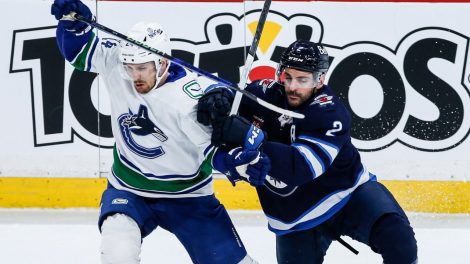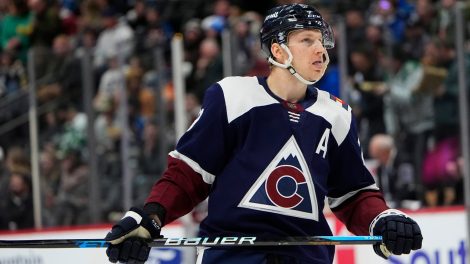Every week we’re using this space to shed some light on a handful of notable trends that warrant further consideration.
Let’s start things off by looking at..
1. Brock Boeser’s importance to the Canucks
The Vancouver Canucks are in the process of free falling down the Pacific Division standings and out of the Western Conference playoff picture.
Exactly two weeks ago, they were sitting in a wild card spot with a modest 14-11-4 record, thanks in large part to the exceptionally steady goaltending they were receiving from their unheralded 1-2 punch in net. The Canucks were third in five-on-five save percentage, and 12th in all situations.
Since then they’ve lost six of seven games and given up 36 goals. The rate at which they’ve been bleeding goals against during this stretch has been reflected in their season-long numbers, dropping them to 16th and 22nd in the two respective save efficiency metrics we’re interested in.
While they’ve been losing on the scoreboard, the only loss that really would’ve mattered in the grand scheme of things would’ve been the one they’d be taking had Brock Boeser’s injury turned out to be as bad as it initially appeared after a shot straight to the foot felled him over the weekend.
His immediate recovery was something of an early Christmas miracle for the Canucks, who have relied upon Boeser in a big way:
| Player | Individual Goals | Team Goals | % Contribution |
|---|---|---|---|
| Alex Ovechkin | 23 | 110 | 20.91 |
| Brock Boeser | 18 | 91 | 19.78 |
| Evander Kane | 14 | 72 | 19.44 |
| Nikita Kucherov | 23 | 125 | 18.40 |
| Anders Lee | 21 | 119 | 17.65 |
| Logan Couture | 15 | 87 | 17.24 |
| Sean Monahan | 16 | 95 | 16.84 |
| Sean Couturier | 15 | 92 | 16.30 |
| Anze Kopitar | 17 | 105 | 16.19 |
| John Tavares | 19 | 119 | 15.97 |
| Mark Stone | 14 | 88 | 15.91 |
| David Pastrnak | 15 | 95 | 15.79 |
| Michael Grabner | 17 | 111 | 15.32 |
| Brayden Schenn | 16 | 105 | 15.24 |
| Clayton Keller | 12 | 79 | 15.19 |
| James Neal | 17 | 113 | 15.04 |
This is one of those metrics that reflects favourably on the individual, while also being rather telling about the state of the team as well. Boeser has undeniably been a revelation in his rookie season in which he’s established himself not only as one of two favourites for the Calder Trophy, but also as one of the league’s most lethal goal scorers.
The Canucks desperately need him on the ice. They play the slowest pace of any team in the league, presumably out of necessity due to the lack of dynamic talent on the roster. If they have any hope of scoring goals and remaining relevant, it’ll be because of Boeser’s brilliance.
But just as importantly, they need him out there because of what he represents in the bigger picture. For such a disgruntled fan base that’s been so starved of hope and something to root for, Boeser’s emergence feeds that need. He’s single-handedly provided a reason to watch the games on TV, go to them in person, and believe there’s a future plan worth investing in.
2. Everyone gets a goal when the New York Islanders play
A couple of weeks ago I lamented the fact that Ken Hitchcock had tightened the screws in Dallas, robbing the hockey world of its most exhilaratingly watchable team. While it may prove to be good for the Stars in the long run, there’s no question it’s been a net negative for those of us who watch hockey on a nightly basis.
Thankfully, the New York Islanders appear to have filled that void. Their games are one big adrenaline rush that have given all the offence you can handle, handing out goals like Oprah gives out cars. They’ve turned back the clock and look like the 2008-09 Detroit Red Wings on offence, while simultaneously resembling the 2008-09 Atlanta Thrashers on defence.
The result of that combination is a team that’s on pace to shatter the glass ceiling for most combined goals for and against in a single season since 2007:
| Team | Season | Goals For | Goals Against | Total Goals |
|---|---|---|---|---|
| NYI | 2017-2018 | 287* | 287* | 574* |
| WSH | 2009-2010 | 313 | 227 | 540 |
| ATL | 2008-2009 | 250 | 279 | 529 |
| TOR | 2008-2009 | 242 | 283 | 525 |
| DET | 2008-2009 | 285 | 237 | 522 |
| DAL | 2014-2015 | 257 | 257 | 514 |
| TBL | 2011-2012 | 232 | 278 | 510 |
| COL | 2010-2011 | 221 | 287 | 508 |
| WSH | 2008-2009 | 268 | 240 | 508 |
| PIT | 2016-2017 | 278 | 229 | 507 |
| WPG | 2016-2017 | 246 | 255 | 501 |
| CAR | 2007-2008 | 250 | 246 | 496 |
| DET | 2010-2011 | 257 | 237 | 494 |
| OTT | 2007-2008 | 257 | 237 | 494 |
| DAL | 2015-2016 | 265 | 228 | 493 |
*82-game pace
The Islanders are a fascinating bunch. The emergence of Mathew Barzal as a viable sidekick to John Tavares has undoubtedly made them tougher to deal with, as they finally have a second scoring line for the opposition to contend with.
The issue is that as good as the top of their lineup is, the pieces on the margins are just as bad. There are holes throughout that need to be tended to immediately, particularly in net, where the combination of Jaroslav Halak and Thomas Greiss has been disastrously porous. All the way down at .892 for the season, no duo has stopped a lower percentage of the shots they’ve faced.
There doesn’t appear to be any no-brainer solutions available, but at this point even rolling the dice on someone from the group of Jimmy Howard, Petr Mrazek, Michal Neuvirth, or Anders Nilsson seems like a more palatable alternative.
The good news is the areas that need fixing are abundantly obvious, and they should be able to do it. With John Tavares’ free agency on the horizon and the move to a new rink looming not long after, the willingness to act with some urgency should also be there for GM Garth Snow. Making moves just to appease the fanbase isn’t typically a good enough reason, but the specifics of this particular case seem like a unique exception to the rule.
That’ll make the Islanders a team to watch closely in the second half of the year, as trade deadline season fast approaches. In the meantime, they’ll remain immensely watchable – just maybe for the wrong reason.
[snippet id=3317857]
3. Henrik Lundqvist and Cory Schneider have returned to form
The timing here is admittedly cruel after just laying out how mighty the Islanders have struggled to get a save. Their two closest Metropolitan Division rivals can’t relate, as some semblance of normalcy has been restored in the NHL.
We’d come to know only three things to be certain in the hockey world: Death, Taxes, and Henrik Lundqvist and Cory Schneider casually posting save percentages above the .920 mark. That was true until last year, when both uncharacteristically dipped not only below that lofty standard, but under the league average as well:

There was reason to be concerned about both, for different reasons. In Lundqvist’s case, it was the combination of age and tread on the tires. He’s now 35 years old and is approaching 800 career NHL appearances. Father Time eventually catches up to everyone, regardless of how handsome they may be. For Schneider, the concern was around his lower body injuries, which can be awfully troubling for a goaltender.
Thankfully, it appears those concerns were premature, at least for the time being. At such an unpredictable position, Lundqvist and Schneider’s gold standard of consistency was one of the few things we thought we knew we could count on. After one down year, they both appear to have returned to form.
4. Kyle Turris has added a new wrinkle in Nashville
It appears the Kevin Fiala breakout we’ve been anticipating for some time now is finally happening. No one has benefited more from the arrival of Kyle Turris than Fiala, as we can draw a pretty neat link between Turris’ acquisition and Fiala’s uptick in production.
Kevin Fiala pre-Turris trade: 15 games, 0 goals, 7 assists, 15 shots on goal
Kevin Fiala post-Turris trade: 17 games, 9 goals, 9 assists, 54 shots on goal
Likewise, Turris has seemingly enjoyed the change of scenery, hovering around a point-per-game himself, despite seeing less ice-time and not filling as significant a role. The two of them, along with Craig Smith, have given the Predators a second lethal forward line, which has made them a nightmare to match up against:
| Player 1 | Player 2 | Player 3 | Corsi For % | Fenwick For % | Shots For % | Goals For % | Expected Goals For % |
|---|---|---|---|---|---|---|---|
| Ryan Johansen | Filip Forsberg | Viktor Arvidsson | 57.06 | 57.38 | 59.57 | 66.06 | 54.34 |
| Kyle Turris | Kevin Fiala | Craig Smith | 56.25 | 57.49 | 54.6 | 66.38 | 59.31 |
How Peter Laviolette ultimately chooses to fill out the bottom-six remains to be seen, but assuming health he certainly won’t be short on intriguing options to mix and match with until he finds a permanent fit. This is made easier now that the heavy lifting at the top of the lineup is set.
When the Predators have been at their best in the past, they fly around the ice at a mesmerizingly fast pace and throw different looks at their opponents. This year they’ve relied on their goaltending a tad too much, and the team’s relatively underwhelming underlying numbers reflect that. But with Turris and a second legitimate scoring line, things finally appear to be trending in the right direction.
(All data via Corsica and Natural Stat Trick)
[relatedlinks]








